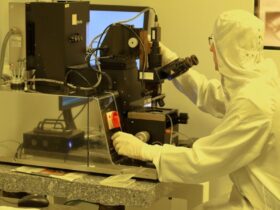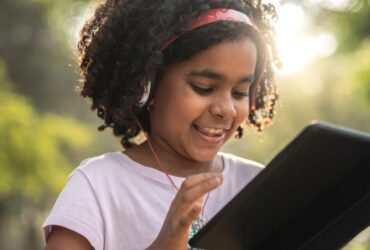A digital classroom is a classroom that uses computers, internet, and educational software to enhance student learning. It can be an extension of the physical classroom that provides additional opportunities for collaboration and research.
As technology continues to evolve, it has started transforming the traditional classrooms into a digital classroom. In a digital classroom, students are provided with a range of online learning opportunities, which they can access 24/7 from their homes. This makes it possible to break out the learning process from the restrictions of physical time and space.
The electronic devices such as smart interactive boards, computers, acoustic devices, software, and internet connection provided in digital classrooms provide a unique interactive experience to students. In this environment, students are encouraged to take control of their own learning, communicate effectively, and develop technological skills that will be useful in their future careers. We will discuss the features, benefits, challenges, and future of digital classrooms.
What Is A Digital Classroom?
HTML format suitable for WordPress:
A digital classroom is a classroom that utilizes computers, tablets, the internet, and educational software to enhance and supplement student learning. The digital classroom can be seen as an extension of the physical classroom that provides additional opportunities for collaboration, research, and learning. In this article, we will explore the definition, elements, and role of the digital classroom.
Definition
A digital classroom is a classroom that integrates electronic devices such as smart interactive blackboards, acoustic devices, computers, an internet connection, and software to enhance the teaching and learning process. The digital classroom is intended to increase the effectiveness of learning while providing a personalized learning environment. In a digital classroom, students can interact with the digital material, which activates multiple senses, leading to better memory retention and improved attention span.
Elements
The elements of a digital classroom include:
- Electronic devices such as smartboards, tablets, and computers
- A fast and reliable internet connection that allows for research and online collaboration with peers
- Educational software that enriches the classroom experience by providing personalized learning opportunities and adaptive assessments
- State-of-the-art audio and visual systems that improve the quality of online learning
- Adaptive learning spaces that can be flexibly rearranged to support different group sizes and activities
- Online platforms that improve communication between teachers, students, and parents
Role
The role of the digital classroom is to break free from traditional restrictions of time and space. The digital classroom allows students to learn at their own pace, creating a more personalized learning experience. Additionally, the digital classroom provides students with access to a wealth of information, allowing them to conduct online research and learn at all times, making education more accessible and adaptable. The digital classroom also helps students develop critical thinking and digital skills that are increasingly necessary to succeed in the modern world.
Inside The Digital Classroom
A digital classroom is a modern approach to teaching that incorporates technology in the learning process. It employs electronic devices such as computers, tablets, and educational software, providing opportunities for collaboration and research beyond the traditional classroom environment.
Inside the Digital Classroom
The modern era has revolutionized the education industry, and the traditional classroom is being replaced with the digital classroom. A digital classroom is a classroom that uses electronic devices, the internet, and educational software to enhance the teaching and learning process. While traditional classrooms are limited to physical proximity, digital classrooms break free from these restrictions and provide a new horizon of learning. In this post, we will explore the inside of the digital classroom by focusing on Centennial College and Global Schools Foundation.
Centennial College
Centennial College is one of the prime examples of successful implementation of a digital classroom. With the help of sophisticated technology, Centennial College has transformed its traditional classrooms into modern digital classrooms. The college provides its students with state-of-the-art audio and visual systems, interactive whiteboards, and other modern equipment, which has unleashed new opportunities for collaboration and research. The digital classroom is an extension of the physical classroom that enables students to connect with each other and their instructors beyond the traditional classroom environment.
Global Schools Foundation
Global Schools Foundation is another leading educational institute that has transformed its classrooms into modern digital classrooms. The foundation has introduced an adaptive learning space, where students can work individually or in groups, using laptops, tablets, and other electronic devices. The foundation provides its students with high-speed internet, which is essential for research and collaboration purposes. Moreover, the foundation has implemented advanced security systems to ensure the safety and privacy of its students.
In conclusion, a digital classroom is changing the way we learn and has provided a new horizon for students and educators. With the help of modern technology and state-of-the-art equipment, educational institutes such as Centennial College and Global Schools Foundation have successfully implemented digital classrooms that have revolutionized the traditional classroom environment. With the ever-changing technological landscape, the future of education lies in digital classrooms.
How To Set Up Your Digital Classroom For Success
Learn how to set up a digital classroom for success with Common Sense Education’s step-by-step guide. A digital classroom is one that uses technology, such as computers, tablets, and educational software, to enhance student learning and provide additional opportunities for collaboration and research.
“How to Set Up Your Digital Classroom for Success”
Setting up a digital classroom can seem like a daunting task. However, with a few simple steps, you can ensure that your digital classroom is ready for a successful educational experience. Think of your digital classroom as an extension of your physical classroom, and you will soon realize that setting up a digital classroom is not as complicated as it may seem.
Think of your digital classroom as an extension of your physical classroom
Your digital classroom should feel just as welcoming and familiar as your physical classroom. It is essential to create a comfortable and engaging space that contributes to the overall learning experience. Consider integrating your physical classroom decorations, such as posters and decor, into your digital classroom.
Create a safe and secure place to store and charge devices
It is crucial to ensure that your students’ devices are secure and charged correctly. You can create a charging station in your classroom to ensure that all devices are charged and ready for use. You can also assign storage spaces for each student’s device to ensure their safety.
Communicate with students about when to use devices
It is essential to establish rules and procedures for the appropriate use of devices in the digital classroom. Communicate with your students about when they can use their devices and when they need to put them away. Setting specific guidelines will help your students understand when and how to use their devices correctly.
Manage kids’ online and digital work
Managing your students’ digital work can be a daunting task, but it doesn’t have to be. You can use digital tools and platforms to manage and organize your students’ work. Make sure to educate your students on how to use these tools and platforms correctly.
Three tips to get your digital classroom party started
1. Start with the basics: Choose the right software and equipment for your digital classroom.
2. Engage your students: Encourage your students to collaborate and interact with each other through digital tools and platforms.
3. Keep it simple: Don’t overwhelm your students with too many digital tools or platforms. Stick to a few essential tools that support and enhance their learning experience.
In conclusion, setting up a digital classroom is not as complicated as it may seem. By following a few simple steps, you can create a comfortable, safe, and engaging environment for your students. Remember to treat your digital classroom as an extension of your physical classroom, and you will soon see the benefits of incorporating digital tools and platforms into your teaching practice.

Credit: www.amazon.com

Credit: www.researchgate.net
Frequently Asked Questions On What Is A Digital Classroom
What Is The Meaning Of Digital Classroom?
A digital classroom is a classroom that incorporates computers, tablets, the internet, and educational software to improve student learning. It can work as an extension of the physical classroom by providing additional opportunities for collaboration and research. Electronic devices like smart interactive blackboards, computers, internet connections, and software are integrated into the digital classroom to enhance the teaching and learning process.
Digital classrooms break out learning from physical time and space and help students stay connected through virtual lessons, digital discussions, and more.
What Are The Elements Of A Digital Classroom?
A digital classroom is a classroom that uses computers, tablets, internet connection, educational software, and electronic devices such as smart interactive blackboards and acoustic devices to supplement the teaching and learning process. The elements of a digital classroom include state-of-the-art audio and visual systems, adaptive learning spaces, safe and secure device storage, and effective communication and management of students’ digital work.
It enables virtual lessons, digital discussions and collaborations, and expands learning beyond physical classrooms.
What Is The Difference Between Digital Classroom And Online Classroom?
A digital classroom refers to a classroom that uses computers, tablets, the internet and educational software to enhance student learning. It can be an extension of the physical classroom that provides extra opportunities for collaboration and research. Online learning only involves learning through the internet while digital learning encompasses several aspects of technology.
What Is The Role Of The Digital Classroom?
A digital classroom is a classroom that uses computers, tablets, internet, and educational software to enhance student learning. It offers additional opportunities for collaboration and research and can break out learning from the restrictions of physical time and space. With a digital classroom, students can stay connected through virtual lessons, digital discussions, and more, even if they need to learn from home due to illness.
What Devices Are Used In A Digital Classroom?
In a digital classroom, electronic devices such as computers, tablets, and smartphones are used to access course materials and educational software.
Conclusion
As we’ve seen, a digital classroom is a classroom that uses technology to enhance student learning. It can provide additional opportunities for collaboration, research, and learning beyond the physical classroom. With the integration of electronic devices such as smart interactive blackboards, acoustic devices, computers, and the internet, students can learn from anywhere and at any time.
By breaking the restrictions of physical time and space, a digital classroom can provide access to education in new and innovative ways. As we move forward, it’s clear that digital classrooms will continue to play an important role in education.












































Leave a Reply